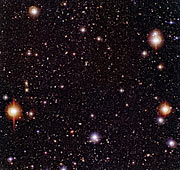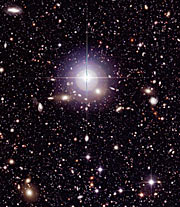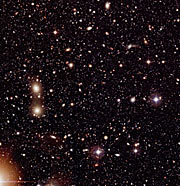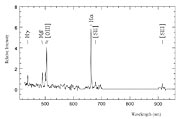Press Release
Deepest Wide-Field Colour Image in the Southern Sky
La Silla camera observes Chandra Deep Field South
10 January 2003
The combined efforts of three European teams of astronomers, targeting the same sky field in the southern constellation Fornax (The Oven) have enabled them to construct a very deep, true-colour image - opening an exceptionally clear view towards the distant universe. The image ( PR Photo 02a/03 ) covers an area somewhat larger than the full moon. It displays more than 100,000 galaxies, several thousand stars and hundreds of quasars. It is based on images with a total exposure time of nearly 50 hours, collected under good observing conditions with the Wide Field Imager (WFI) on the MPG/ESO 2.2m telescope at the ESO La Silla Observatory (Chile) - many of them extracted from the ESO Science Data Archive.
The position of this southern sky field was chosen by Riccardo Giacconi (Nobel Laureate in Physics 2002) at a time when he was Director General of ESO, together with Piero Rosati (ESO). It was selected as a sky region towards which the NASA Chandra X-ray satellite observatory, launched in July 1999, would be pointed while carrying out a very long exposure (lasting a total of 1 million seconds, or 278 hours) in order to detect the faintest possible X-ray sources. The field is now known as the Chandra Deep Field South (CDF-S) .
The new WFI photo of CDF-S does not reach quite as deep as the available images of the "Hubble Deep Fields" (HDF-N in the northern and HDF-S in the southern sky, but the field-of-view is about 200 times larger. The present image displays about 50 times more galaxies than the HDF images, and therefore provides a more representative view of the universe .
The WFI CDF-S image will now form a most useful basis for the very extensive and systematic census of the population of distant galaxies and quasars, allowing at once a detailed study of all evolutionary stages of the universe since it was about 2 billion years old .
These investigations have started and are expected to provide information about the evolution of galaxies in unprecedented detail. They will offer insights into the history of star formation and how the internal structure of galaxies changes with time and, not least, throw light on how these two evolutionary aspects are interconnected.
Galaxies in the WFI image
The WFI CDF-S colour image - of which the full field is shown in ESO Press Photo eso0302a - was constructed from all available observations in the optical B-,V- and R-bands obtained under good conditions with the Wide Field Imager (WFI) on the 2.2-m MPG/ESO telescope at the ESO La Silla Observatory (Chile), and now stored in the ESO Science Data Archive.
It is the "deepest" image ever taken with this instrument. It covers a sky field measuring 36 x 34 arcmin 2, i.e., an area somewhat larger than that of the full moon. The observations were collected during a period of nearly four years, beginning in January 1999 when the WFI instrument was first installed and ending in October 2002. Altogether, nearly 50 hours of exposure were collected in the three filters combined here, cf. the technical information below.
Although it is possible to identify more than 100,000 galaxies in the image - some of which are shown in ESO Press Photo eso0302b - it is still remarkably "empty" by astronomical standards. Even the brightest stars in the field (of visual magnitude 9) can hardly be seen by human observers with binoculars. In fact, the area density of bright, nearby galaxies is only half of what it is in "normal" sky fields. Comparatively empty fields like this one provide an unsually clear view towards the distant regions in the universe and thus open a window towards the earliest cosmic times .
Research projects in the Chandra Deep Field South
Astronomers from different teams and disciplines have been quick to join forces in a world-wide co-ordinated effort around the Chandra Deep Field South. Observations of this area are now being performed by some of the most powerful astronomical facilities and instruments. They include space-based X-ray and infrared observations by the ESA XMM-Newton , the NASA CHANDRA , Hubble Space Telescope (HST) and soon SIRTF (scheduled for launch in a few months), as well as imaging and spectroscopical observations in the infrared and optical part of the spectrum by telescopes at the ground-based observatories of ESO (La Silla and Paranal) and NOAO (Kitt Peak and Tololo).
A huge database is currently being created that will help to analyse the evolution of galaxies in all currently feasible respects. All participating teams have agreed to make their data on this field publicly available, thus providing the world-wide astronomical community with a unique opportunity to perform competitive research, joining forces within this vast scientific project.
Concerted observations
The optical true-colour WFI image presented here forms an important part of this broad, concerted approach. It combines observations of three scientific teams that have engaged in complementary scientific projects, thereby capitalizing on this very powerful combination of their individual observations. The following teams are involved in this work:
- COMBO-17 (Classifying Objects by Medium-Band Observations in 17 filters) : an international collaboration led by Christian Wolf and other scientists at the Max-Planck-Institut für Astronomie (MPIA, Heidelberg, Germany). This team used 51 hours of WFI observing time to obtain images through five broad-band and twelve medium-band optical filters in the visual spectral region in order to measure the distances (by means of "photometric redshifts") and star-formation rates of about 10,000 galaxies, thereby also revealing their evolutionary status.
- EIS (ESO Imaging Survey) : a team of visiting astronomers from the ESO community and beyond, led by Luiz da Costa (ESO). They observed the CDF-S for 44 hours in six optical bands with the WFI camera on the MPG/ESO 2.2-m telescope and 28 hours in two near-infrared bands with the SOFI instrument at the ESO 3.5-m New Technology Telescope (NTT) , both at La Silla. These observations form part of the Deep Public Imaging Survey that covers a total sky area of 3 square degrees.
- GOODS (The Great Observatories Origins Deep Survey) : another international team (on the ESO side, led by Catherine Cesarsky ) that focusses on the coordination of deep space- and ground-based observations on a smaller, central area of the CDF-S in order to image the galaxies in many differerent spectral wavebands, from X-rays to radio. GOODS has contributed with 40 hours of WFI time for observations in three broad-band filters that were designed for the selection of targets to be spectroscopically observed with the ESO Very Large Telescope (VLT) at the Paranal Observatory (Chile), for which over 200 hours of observations are planned. About 10,000 galaxies will be spectroscopically observed in order to determine their redshift (distance), star formation rate, etc.
Another important contribution to this large research undertaking will come from the GEMS project. This is a "HST treasury programme" (with Hans-Walter Rix from MPIA as Principal Investigator) which observes the 10,000 galaxies identified in COMBO-17 - and eventually the entire WFI-field with HST - to show the evolution of their shapes with time.
Great questions
With the combination of data from many wavelength ranges now at hand, the astronomers are embarking upon studies of the many different processes in the universe. They expect to shed more light on several important cosmological questions, such as:
- How and when was the first generation of stars born?
- When exactly was the neutral hydrogen in the universe ionized the first time by powerful radiation emitted from the first stars and active galactic nuclei?
- How did galaxies and groups of galaxies evolve during the past 13 billion years?
- What is the true nature of those elusive objects that are only seen at the infrared and submillimetre wavelengths?
- Which fraction of galaxies had an "active" nucleus (probably with a black hole at the centre) in their past, and how long did this phase last?
Moreover, since these extensive optical observations were obtained in the course of a dozen observing periods during several years, it is also possible to perform studies of certain variable phenomena:
- How many variable sources are seen and what are their types and properties?
- How many supernovae are detected per time interval, i.e. what is the supernovae frequency at different cosmic epochs?
- How do those processes depend on each other?
This is just a short and very incomplete list of questions astronomers world-wide will address using all the complementary observations. No doubt that the coming studies of the Chandra Deep Field South - with this and other data - will be most exciting and instructive!
More information
Other wide-field images from the WFI have been published in various ESO press releases during the past four years - they are also available at the WFI Photo Gallery . A collection of full-resolution files (TIFF-format) is available on a WFI CD-ROM .
About the Release
| Release No.: | eso0302 |
| Legacy ID: | Photo 02a-d/03 |
| Name: | Chandra Deep Field South, Virgo Cluster |
| Type: | Early Universe : Galaxy : Grouping : Cluster |
| Facility: | MPG/ESO 2.2-metre telescope |
| Instruments: | WFI |
Our use of Cookies
We use cookies that are essential for accessing our websites and using our services. We also use cookies to analyse, measure and improve our websites’ performance, to enable content sharing via social media and to display media content hosted on third-party platforms.
ESO Cookies Policy
The European Organisation for Astronomical Research in the Southern Hemisphere (ESO) is the pre-eminent intergovernmental science and technology organisation in astronomy. It carries out an ambitious programme focused on the design, construction and operation of powerful ground-based observing facilities for astronomy.
This Cookies Policy is intended to provide clarity by outlining the cookies used on the ESO public websites, their functions, the options you have for controlling them, and the ways you can contact us for additional details.
What are cookies?
Cookies are small pieces of data stored on your device by websites you visit. They serve various purposes, such as remembering login credentials and preferences and enhance your browsing experience.
Categories of cookies we use
Essential cookies (always active): These cookies are strictly necessary for the proper functioning of our website. Without these cookies, the website cannot operate correctly, and certain services, such as logging in or accessing secure areas, may not be available; because they are essential for the website’s operation, they cannot be disabled.
Functional Cookies: These cookies enhance your browsing experience by enabling additional features and personalization, such as remembering your preferences and settings. While not strictly necessary for the website to function, they improve usability and convenience; these cookies are only placed if you provide your consent.
Analytics cookies: These cookies collect information about how visitors interact with our website, such as which pages are visited most often and how users navigate the site. This data helps us improve website performance, optimize content, and enhance the user experience; these cookies are only placed if you provide your consent. We use the following analytics cookies.
Matomo Cookies:
This website uses Matomo (formerly Piwik), an open source software which enables the statistical analysis of website visits. Matomo uses cookies (text files) which are saved on your computer and which allow us to analyze how you use our website. The website user information generated by the cookies will only be saved on the servers of our IT Department. We use this information to analyze www.eso.org visits and to prepare reports on website activities. These data will not be disclosed to third parties.
On behalf of ESO, Matomo will use this information for the purpose of evaluating your use of the website, compiling reports on website activity and providing other services relating to website activity and internet usage.
Matomo cookies settings:
Additional Third-party cookies on ESO websites: some of our pages display content from external providers, e.g. YouTube.
Such third-party services are outside of ESO control and may, at any time, change their terms of service, use of cookies, etc.
YouTube: Some videos on the ESO website are embedded from ESO’s official YouTube channel. We have enabled YouTube’s privacy-enhanced mode, meaning that no cookies are set unless the user actively clicks on the video to play it. Additionally, in this mode, YouTube does not store any personally identifiable cookie data for embedded video playbacks. For more details, please refer to YouTube’s embedding videos information page.
Cookies can also be classified based on the following elements.
Regarding the domain, there are:
- First-party cookies, set by the website you are currently visiting. They are stored by the same domain that you are browsing and are used to enhance your experience on that site;
- Third-party cookies, set by a domain other than the one you are currently visiting.
As for their duration, cookies can be:
- Browser-session cookies, which are deleted when the user closes the browser;
- Stored cookies, which stay on the user's device for a predetermined period of time.
How to manage cookies
Cookie settings: You can modify your cookie choices for the ESO webpages at any time by clicking on the link Cookie settings at the bottom of any page.
In your browser: If you wish to delete cookies or instruct your browser to delete or block cookies by default, please visit the help pages of your browser:
Please be aware that if you delete or decline cookies, certain functionalities of our website may be not be available and your browsing experience may be affected.
You can set most browsers to prevent any cookies being placed on your device, but you may then have to manually adjust some preferences every time you visit a site/page. And some services and functionalities may not work properly at all (e.g. profile logging-in, shop check out).
Updates to the ESO Cookies Policy
The ESO Cookies Policy may be subject to future updates, which will be made available on this page.
Additional information
For any queries related to cookies, please contact: pdprATesoDOTorg.
As ESO public webpages are managed by our Department of Communication, your questions will be dealt with the support of the said Department.





